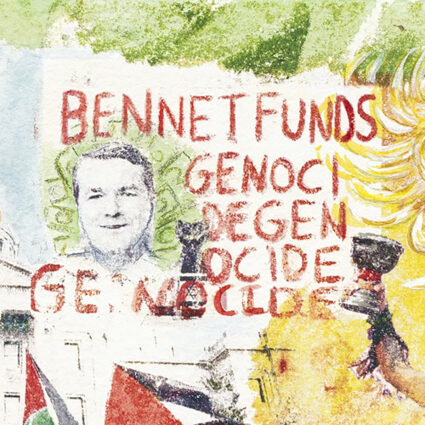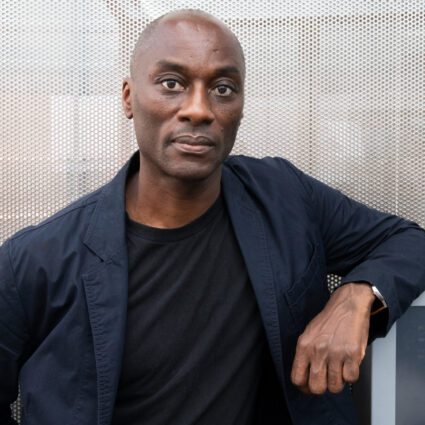
Every now and then modern societies erupt in what Noam Chomsky calls “outbreaks of democracy.” These can take many forms, from political revolution to resistance, and various art movements can be viewed as versions of such outbreaks. Eventually, outbreaks are suppressed, die down through entropy, or are recuperated by (sucked back into) the mainstream. Beatniks and hippies were absorbed into the all-encompassing menu of “lifestyles” available in the mass-consumption sphere. Rebellious rock and roll is now a major industry dealing in stars, brands, and products. In the arts, what was uniquely original and disruptive for one generation becomes just another option for the next.
In the middle of the last century, a motley group of European intellectuals, highly influenced by the avant-garde cinema and visual-poetry movement called Letterism, self-identified as the Situationist International (SI). They articulated the plight in which we still find ourselves, calling it The Society of the Spectacle, “a social relation among people that is mediated by images.” Their analysis was based on a deep historical perspective provided by rarified educations. (Today such a perspective and such an education are scarce luxuries.) They meant advertising—at the time in print media, television, and public space—but their alarm seems only more relevant now as the internet increasingly becomes the sole source of information and the primary avenue for our communications, entertainment, banking, and shopping. Over fifty years ago, Situationism (as well as writer Philip K. Dick) lucidly and precisely saw us now: surrounded and overwhelmed by media and the devices that at first facilitate and then dominate our lives. One of the cores of the SI critique was that actual lived experience had changed from being, to having, to appearing. When social life is dominated by consumer goods, the role of Citizen is smoothly replaced by that of Consumer. Images constructed and chosen by others become the principal connection to the world we formerly experienced for ourselves. The commodity, often just its image, slips into the place of our deep human need for connection and communication. Detached from its context, everything becomes equivalent and infinitely re-combinable. The medium is indeed the message and that message is supremely malleable in the hands of the almighty Market.
Once-transgressive modernist art movements—from Futurism, Dada, and Surrealism to Expressionism, Pop, Minimalism, and Conceptualism—have played roles in shaping and enabling this cultural re-formation. Was that in spite of or because of the fact that representation, the relation of images to their originating context, is a fundamental question for art?
Most civilizations have had countercultures (an excellent guide on the topic is Counterculture Through the Ages: from Abraham to Acid Rock by Dan Joy and R.U. Sirius). Santa Fe was recently visited by Gabriella Coleman, a cultural anthropologist based in Montreal whose previous work has been on hacking and open source platforms. Her recent book Hacker, Hoaxer, Whistleblower, Spy: The Many Faces of Anonymous focuses on the particularly mercurial world of the hackers loosely known as Anonymous—a powerful global iteration of one of these outbreaks. The name immediately conjures for most people a certain mask, probably familiar via the movie V for Vendetta, but that mask has been an icon for much longer.
Icons function as simplifications of persons or things and make concepts immediately available. When the context for an icon becomes mutable, its meaning can be reapplied in new scenarios. A red circle with a bar across it can be combined with practically anything to signify NO!—no smoking, no pooping, no cell phones. Some instantly recognizable paintings—Mona Lisa by Leonardo da Vinci and its 1919 trickster version, Marcel Duchamp’s mustachioed L.H.O.O.Q.—when detached from their originating histories have become icons that have been used to express a wide array of meanings.
The history of the Guy Fawkes mask is a complex case in point. Fawkes was part of a 1605 plot to blow up the English Parliament and overthrow the king. After the execution of Fawkes and his co-conspirators and the defeat of their insurrection, a mustachioed caricature of his visage (the name was Guido, and it may relate to a xenophobic streak in northern Europe against Mediterraneans) quickly became the symbol associated with an evening of carnivalesque bonfires in Britain. (One could speculate on how Santa Fe’s Zozobra is a resonance of this.) Guy Fawkes Night swiftly rotated away from commemoration of the execution of a traitor toward a widely known meme we could call sympathy for the outlaw, an icon of the face of dissent (which is precisely what V for Vendetta was drawing upon). A genre of recent and current mass-market movies (Hunger Games, Ready Player One, Pacific Rim Uprising, even A Wrinkle in Time) rests on an identification with those (especially underdogs, the oppressed, youth) who fight Evil by resisting the ruling order of Power. Mikhail Bakhtin, a Russian literary theorist and philosopher, connected this with the tradition of the carnivalesque—temporary suspension of fixed societal rules in order to let off steam. Historically such festivals are widely distributed from Asia to Latin America to Europe, the Balkans (e.g. the “day the women rule”) and the Mediterranean. Bakhtin lived from 1895 to 1975; his wide-ranging thinking, especially about the dialogic aspect of all culture, can be understood also as an elaborately disguised way of talking back against totalitarianism.

Coleman relates aspects of Anonymous that map directly onto the trope of the Trickster, and of Prometheus, who steals something valuable from the gods and gives it to humanity. A certain degree of flirtation with non-conformism is part of the fabric of contemporary Western civilization, and most young people in Western society go through a phase of it in some form. But in the arts it is often a stronger identification retained into later periods of life; it grew partially out of the Romantic vision of the Artist-as-Hero. This association, along with the vision of the Scientist and even the Engineer as heroic supermen (and yes, it was quite deliberately male-only), migrated into the tech world of the past decade or two. Being “transgressive,” thinking outside of the box, disrupting things, are all seen as positive qualities, especially after a few people became billionaires at it.
In anthropological theory, homo sapiens, our species, further posited as homo faber, the “maker,” is juxtaposed with homo ludens or “player,” concerned with amusements, humor, and leisure. In 1938, as the clouds of Nazi aggression were gathering over Europe, Dutch historian and cultural theorist Johan Huizinga wrote Homo Ludens, emphasizing the importance of play as a sphere of freedom, primary to and necessary for the generation of culture.
A primary motivation for various actions of Anonymous actors is something they call lulz—done mainly for a sort of detached amusement, (the Renaissance called it sprezzatura, being nonchalantly exquisite). This “because it’s there” approach to monkey-wrenching the internet consisted at first of fairly juvenile exercises in transgression, with a built-in global audience for sophisticated digital tinkering. Equally important was the lack of authorship: anonymity insured authenticity. Being done for their own sake rather than for fame and recognition, let alone money, imparted to the hacks and hijinks a transcendent quality. Anonymous happened to evolve from a sub-culture of hacking to something with far-reaching impact; it morphed in a fundamentally unplanned series of steps into what became, in effect, political actions. For example: videos and demonstrations against the draconian methods of the Church of Scientology; enabling the protests in Tunisia that kicked off the Arab Spring; crowd-enabled online attacks on financial institutions in support of early Wikileaks.
Coleman’s work provides revealing reports from her years of “observing” Anonymous. There has always been a fine, sometimes blurred line between participation and observation in cultural anthropology, especially in the contemporary world, where the objects of your study are not an isolated pre-industrial tribe but a globally distributed network of people who may at times be breaking the law. What struck me in her detailed descriptions of Anonymous actions was the intensity and commitment to risk, combined with an attitude of irony and detachment. That combination is a hallmark of many previous such moments in history: Socrates, Taoism, Sufism, Transcendentalism, and bohemianisms of many stripes.
“Most laughter is by nature irreverent, and irreverence is by definition subversive,” says Hugh McLean in his introduction to the works of Mikhail Zoshchenko, titled Nervous People. For twenty-five years, Zoshchenko wrote satirically about people in Stalinist Soviet society, until he too was ritually sacrificed and forced to write drivel. Today, I believe we are all “nervous people.” Extremist right-wing politics is literally borrowing techniques from the political left, tricks that originated in avant-garde artistic movements. As artists, critics, curators, and audiences, we owe it to ourselves to reaffirm a commitment to progressive values—and by that I mean, at minimum, representative democracy, equality under the law, the fundamental dignity of every human being, and a deep commitment to being stewards rather than exploiters of the natural world. Part of this entails recognizing and honoring past traditions of resistance to unbridled power and supporting current outbreaks, such as Black Lives Matter and #MeToo!



